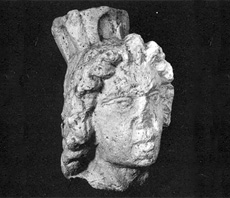The Lapidarium – one of the largest in Hungary and also Europe (after Italy) – contains stone monuments found in and around Aquincum.
Its size is comparable to the lapidarium of the Hungarian National Museum (which has around 250 stone monuments from Aquincum). The lapidarium of the Aquincum Museum contains approximately 1000 stone objects.
The exhibited finds include tombstones, votive altars, building inscriptions, architectural sculptures and – to a lesser extent – everyday items (e.g. grinding stones). Given the range and quantity of the remains, they are first-class sources for ancient historians everywhere concerning the history, composition and religion of the local population as well as military history. The remains without inscriptions, too, are widely used as sources for the history of art, clothing, architecture and industry. More than half of the inventoried remains have inscriptions on them. Most of these inscriptions were published in the first half of the 20th century in the third volume of the Corpus Inscriptionum Latinarum (CIL) with the help of leading ancient historians like Th. Mommsen or A. von Domaszekwski. Among Hungarian scholars Bálint Kuzsinszky, Sándor Fröhlich, Károly Torma, Lajos Nagy, András Alföldi, János Szilágyi, Tibor Nagy, Géza Alföldi and András Mócsy published the most (important) inscriptions. Every year since the beginning of the 20th century, the journal L’Année Épigraphique has collected inscriptions from finds published in the previous year. Thus, every inscription can be included in the international and – of course – the Hungarian archaeological literature. It can be said that almost the entire Aquincum collection appears systematically in corpuses and the archaeological literature treats it as a key source.
Most of the sculptural remains in the collection are reliefs from grave monuments (tombstones, sepulchral structures and sarcophagi). These reliefs include busts of the deceased, and scenes with sacrificial or funeral feasts as well as carriages. Tombstones decorated with wreaths form a separate group in Aquincum. The Lupa Capitolina (the Capitoline wolf feeding Romulus and Remus) is also depicted on some grave stelae. Plaques depicting mythological scenes were also used for some grave monuments (e.g. Priam plaque). Sarcophagi were also richly decorated (Attius, Genius, Eros, gates of the Underworld etc.). Carvings can also be seen on altars (the snake-motif altar). The collection also holds architectural elements with various designs (e.g. capitals with masks and cornice fragments etc.). Traces of paint can also be observed in various colours on some finds (e.g. the Bitus grave stele). The Aquincum collection of sculptures in the round includes grave sculptures, statues of deities (e.g. Nemesis-Fortuna) and the portraits of emperors and governors etc.
These works of art are outstanding examples of sculptures in the Roman Empire and Pannonia. Apart from sculptures carved from local limestone (e.g. the portrait of Marcus Aurelius), the collection also includes imported sculptures carved from marble (e.g. the governor’s torso). The sculptures in the collection date to the 2nd, 3rd and 4th centuries AD.
The curator of the collection: Tibor Budai-Balogh



